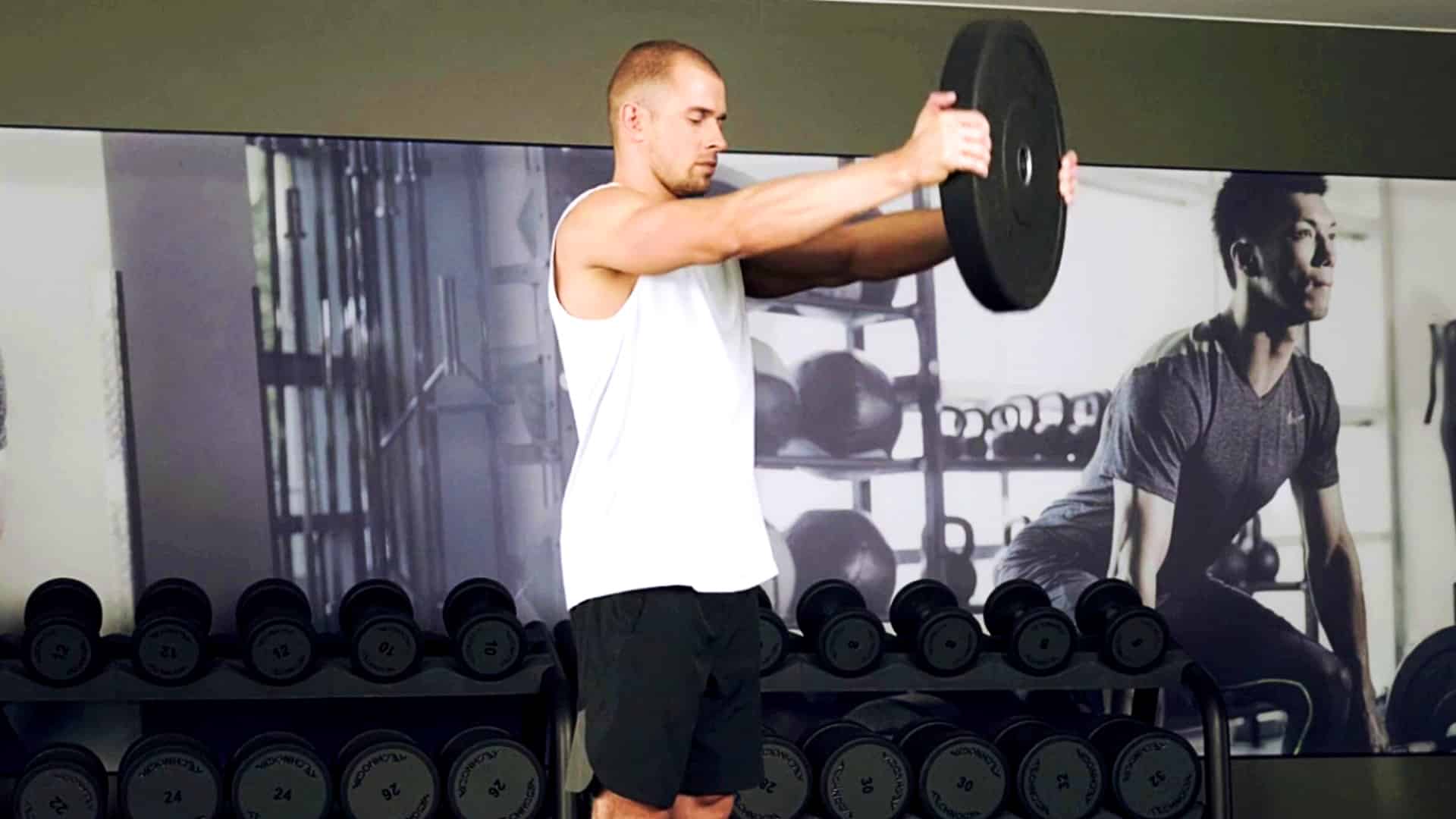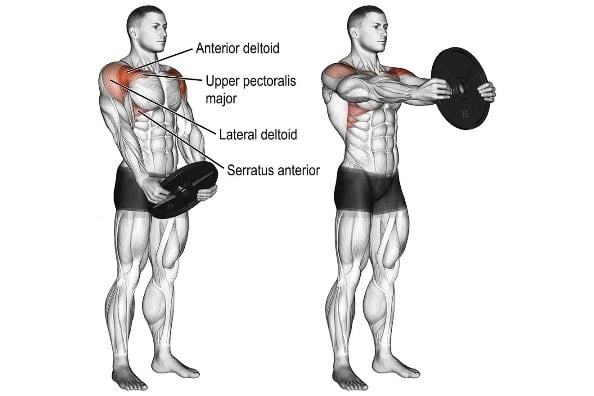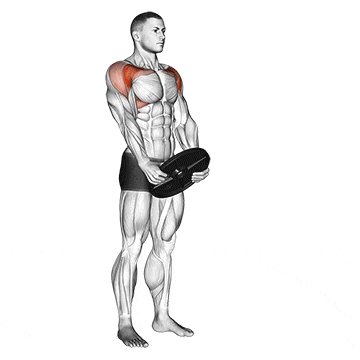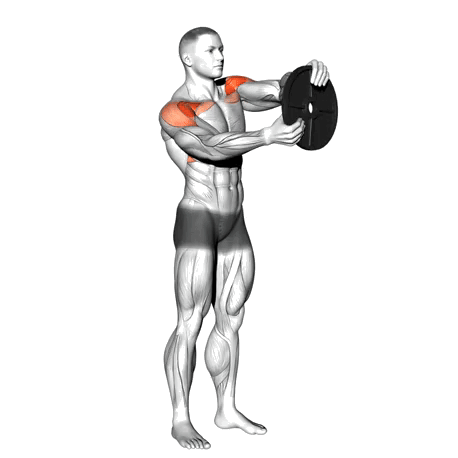The plate front raise is a must-try if you want to build your shoulder definition, improve daily functional strength, or just change up your routine.
This is an isolation exercise, because it only involves one joint (the shoulder) to perform the movement. Unlike compound exercises, polyarticular exercises use several joints, such as the Arnold or military press for the shoulders.
Coming back to front raises, this is a very good exercise for beginners that will allow you to have good sensations, even with light loads.
The plate front raise is an old-school and effective shoulder exercise that primarily targets the anterior deltoid. It is a variation of the traditional front raise exercise, but instead of using dumbbells or a barbell, you use a weight plate.
You can do the plate front raise seated or standing, but it’s best to do it in a standing position with moderate weight.
Want to take your gains to the next level? Discover your daily calorie needs with our free TDEE calculator

Plate Front Raise Muscles Worked
- Primary Muscles worked: Anterior Deltoid (Front Deltoid)
- Secondary Muscles Worked: Serratus Anterior, Upper Pectorals (Upper Chest)
- Stabilizing Muscles: Lower Trapezius, Rectus Abdominis and Obliques and Wrist Flexors and Extensors

How To Do Plate Front Raise
- Stand upright with a firm and stable stance, feet roughly shoulder-width apart.
- Hold a weight plate with both hands at the sides, specifically around the 3 o’clock and 9 o’clock positions.
- Begin with your arms fully extended and the plate resting lightly against your thighs. Your palms should be facing your body.
- Lift the plate straight up in front of you with your elbows slightly bent.
- Elevate the weight until it’s approximately at shoulder height or just before reaching the point where your arms are parallel to the ground.
- Slowly lower the weight plate back to the starting position.
- Do 8–15 reps for 2–4 sets to improve muscle endurance and hypertrophy.
Tips and Form
- Do not use your lower back to power through the motion. Use controlled movements to lift with your delts.
- Maintain a neutral back and engage your core throughout the exercise.
- Do not allow the handle to touch your body, and do not allow your body to move (or swing) throughout the movement.
- Try not to bounce at the top of the movement; allow the shoulders to flex and then lower slowly. This is an isolation exercise, so the focus should be on form and muscle contraction, not weight.
- You can do these variations in place of or in addition to standard front raises.
- Increase the weights with each set, little by little, until the technique deteriorates. Generally, when the load is too heavy to be mastered, the body begins to move back and forth to allow the weights to rise using momentum, and not using muscle contraction.
- Your wrists should be in a neutral position, without bending up or down. If you can’t maintain a neutral position, the weights you’re using are probably too heavy.

Plate Front Raise With Rotation
Adding a twist as you lift, you’re hitting your shoulders from multiple angles in one smooth motion. It’s like getting two exercises for the price of one! Sure, you’re working those front delts, but you’re also bringing your lateral delts into the party.
The rotation also adds a nice little core challenge. As you twist that plate, your abs and obliques must fire up to keep you steady.
The rotation demands focus and control, which improves the mind-muscle connection. This can lead to better muscle recruitment and a better workout.

How To Do
- Grasp a weight plate with both hands. The hands are at the sides of the plate, and the palms of the hands point to each other.
- Your posture is upright, and the feet are hip-width apart.
- Lift the plate up to approximately shoulder height and maximally contract your front delts.
- Hold the arms horizontally. Now rotate the hands. One hand is under the plate, the other on top of it.
- Now rotate to the other side, do several reps, and do not let the body swing.
To Stay Motivated: 150+ Gym Workout Motivational Quotes To Stay Fit
FAQs
What does plate front raise work?
Front Plate Raises primarily work on the Anterior Deltoid. The secondary muscles that work during the plate raise in this lift are the upper pectoralis, trapezius, serratus anterior, and lateral deltoid.
Is plate front raise Good?
Yes, plate front raises are an excellent shoulder exercise for building anterior delts. This shoulder flexion exercise is a great option for building shoulder strength, improving shoulder mobility, and shaping your shoulder muscles.
Is the plate front raise, push, or pull?
Front Plate Raises are a push exercise that helps build strength and definition in the front and sides of your shoulder.
Are Plate raises a good workout?
The front raise is a versatile and effective strength and muscle-building exercise for athletes of all types.
Don’t forget to share your experiences in the comments section below.

Manish is a NASM-certified fitness and nutrition coach with over 10 years of experience in weight lifting and fat loss fitness coaching. He specializes in gym-based training and has a lot of knowledge about exercise, lifting technique, biomechanics, and more.
Through “Fit Life Regime,” he generously shares the insights he’s gained over a decade in the field. His goal is to equip others with the knowledge to start their own fitness journey.
